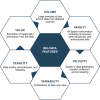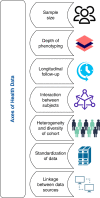Improving child health through Big Data and data science
- PMID: 35974162
- PMCID: PMC9380977
- DOI: 10.1038/s41390-022-02264-9
Improving child health through Big Data and data science
Abstract
Child health is defined by a complex, dynamic network of genetic, cultural, nutritional, infectious, and environmental determinants at distinct, developmentally determined epochs from preconception to adolescence. This network shapes the future of children, susceptibilities to adult diseases, and individual child health outcomes. Evolution selects characteristics during fetal life, infancy, childhood, and adolescence that adapt to predictable and unpredictable exposures/stresses by creating alternative developmental phenotype trajectories. While child health has improved in the United States and globally over the past 30 years, continued improvement requires access to data that fully represent the complexity of these interactions and to new analytic methods. Big Data and innovative data science methods provide tools to integrate multiple data dimensions for description of best clinical, predictive, and preventive practices, for reducing racial disparities in child health outcomes, for inclusion of patient and family input in medical assessments, and for defining individual disease risk, mechanisms, and therapies. However, leveraging these resources will require new strategies that intentionally address institutional, ethical, regulatory, cultural, technical, and systemic barriers as well as developing partnerships with children and families from diverse backgrounds that acknowledge historical sources of mistrust. We highlight existing pediatric Big Data initiatives and identify areas of future research. IMPACT: Big Data and data science can improve child health. This review highlights the importance for child health of child-specific and life course-based Big Data and data science strategies. This review provides recommendations for future pediatric-specific Big Data and data science research.
© 2022. The Author(s), under exclusive licence to the International Pediatric Research Foundation, Inc.
Conflict of interest statement
The authors declare no competing interests.
Figures
References
-
- GBD 2017 Child and Adolescent Health Collaborators. Reiner RC, et al. Diseases, injuries, and risk factors in child and adolescent health, 1990 to 2017: findings from the Global Burden of Diseases, Injuries, and Risk Factors 2017 Study. JAMA Pediatr. 2019;173:e190337. doi: 10.1001/jamapediatrics.2019.0337. - DOI - PMC - PubMed
-
- Ely DM, Driscoll AK. Infant mortality in the United States, 2017: data from the period linked birth/infant death file. Natl Vital Stat. Rep. 2019;68:1–20. - PubMed
Publication types
MeSH terms
Grants and funding
LinkOut - more resources
Full Text Sources
Medical
Miscellaneous



